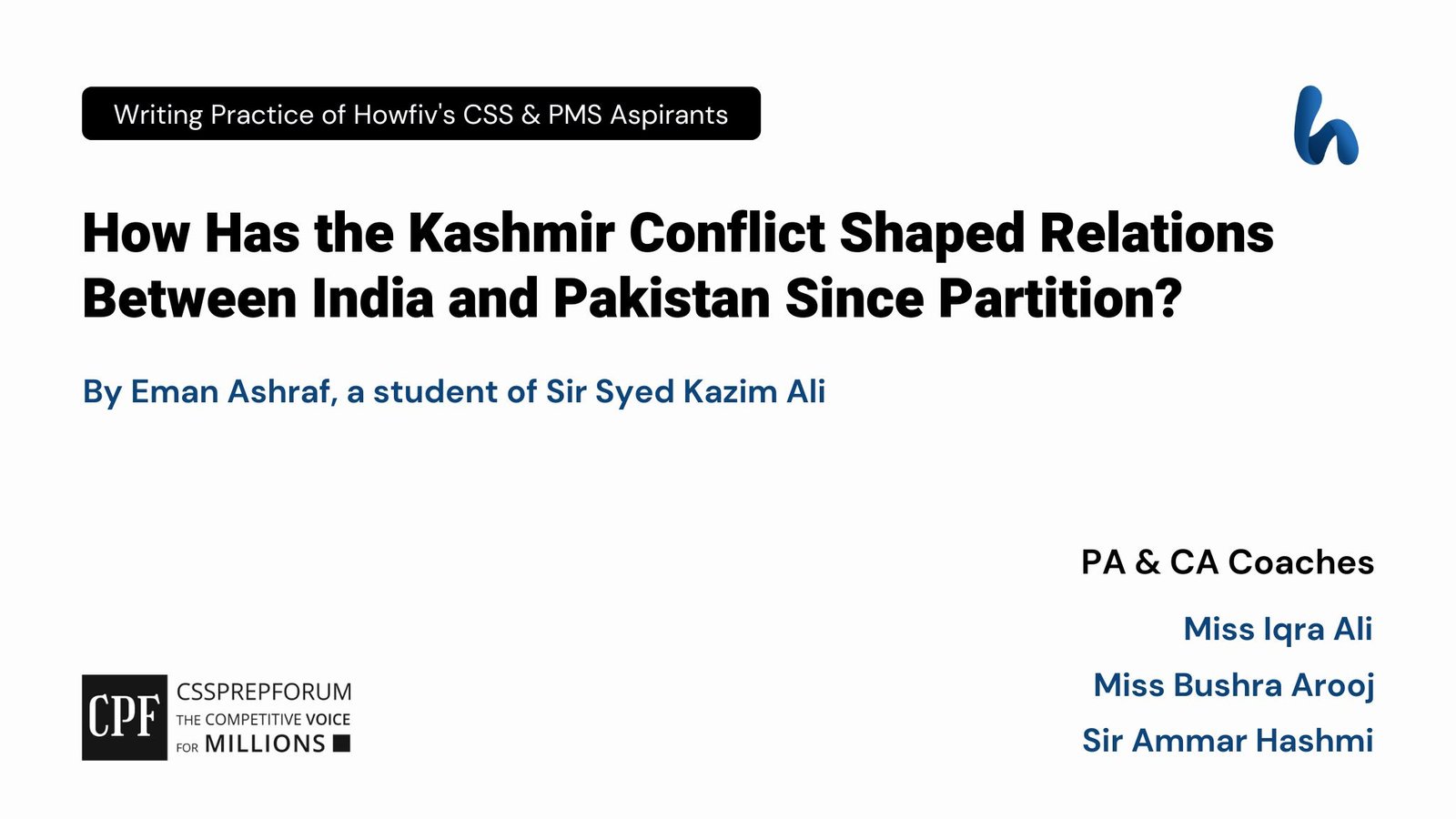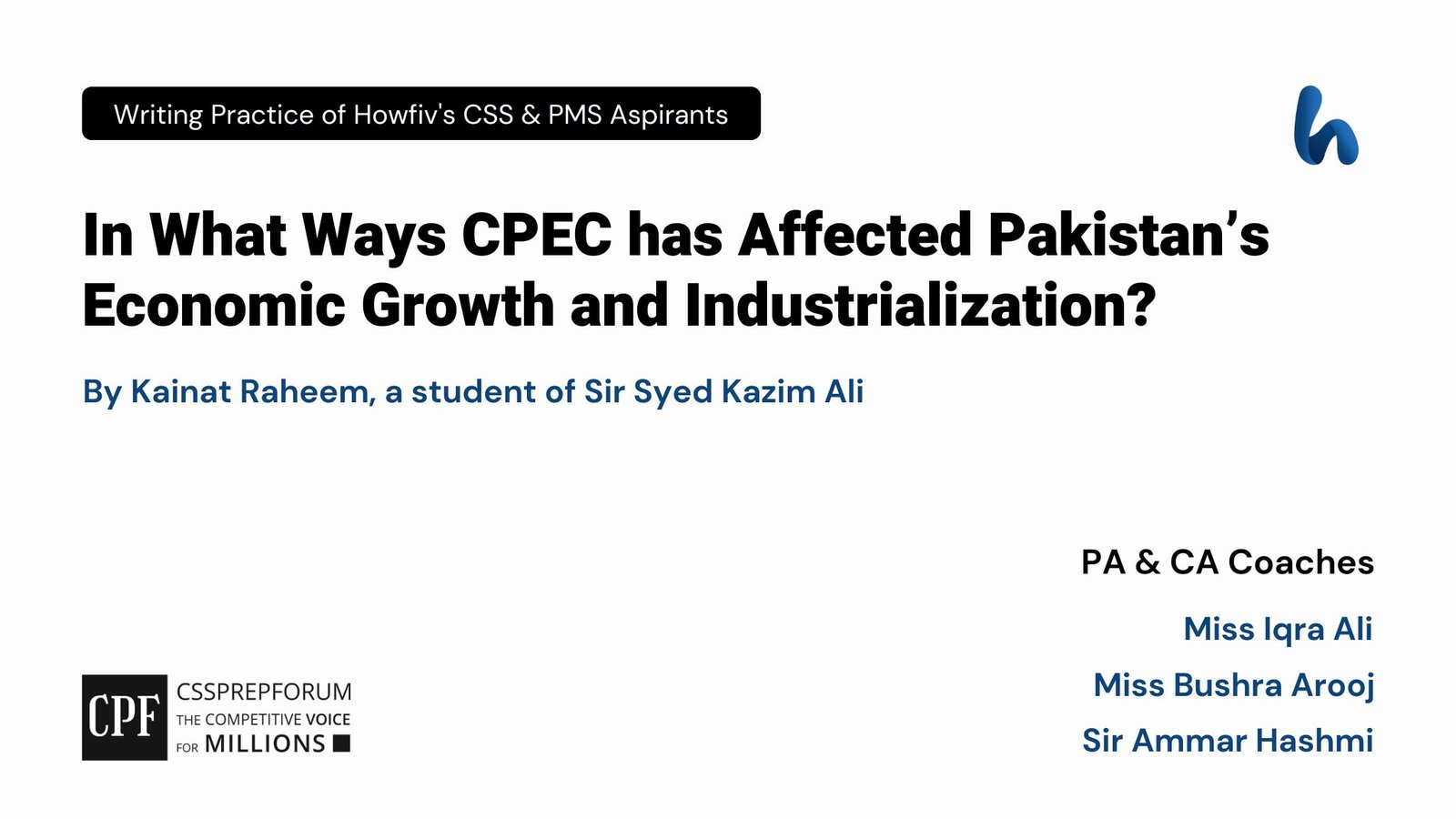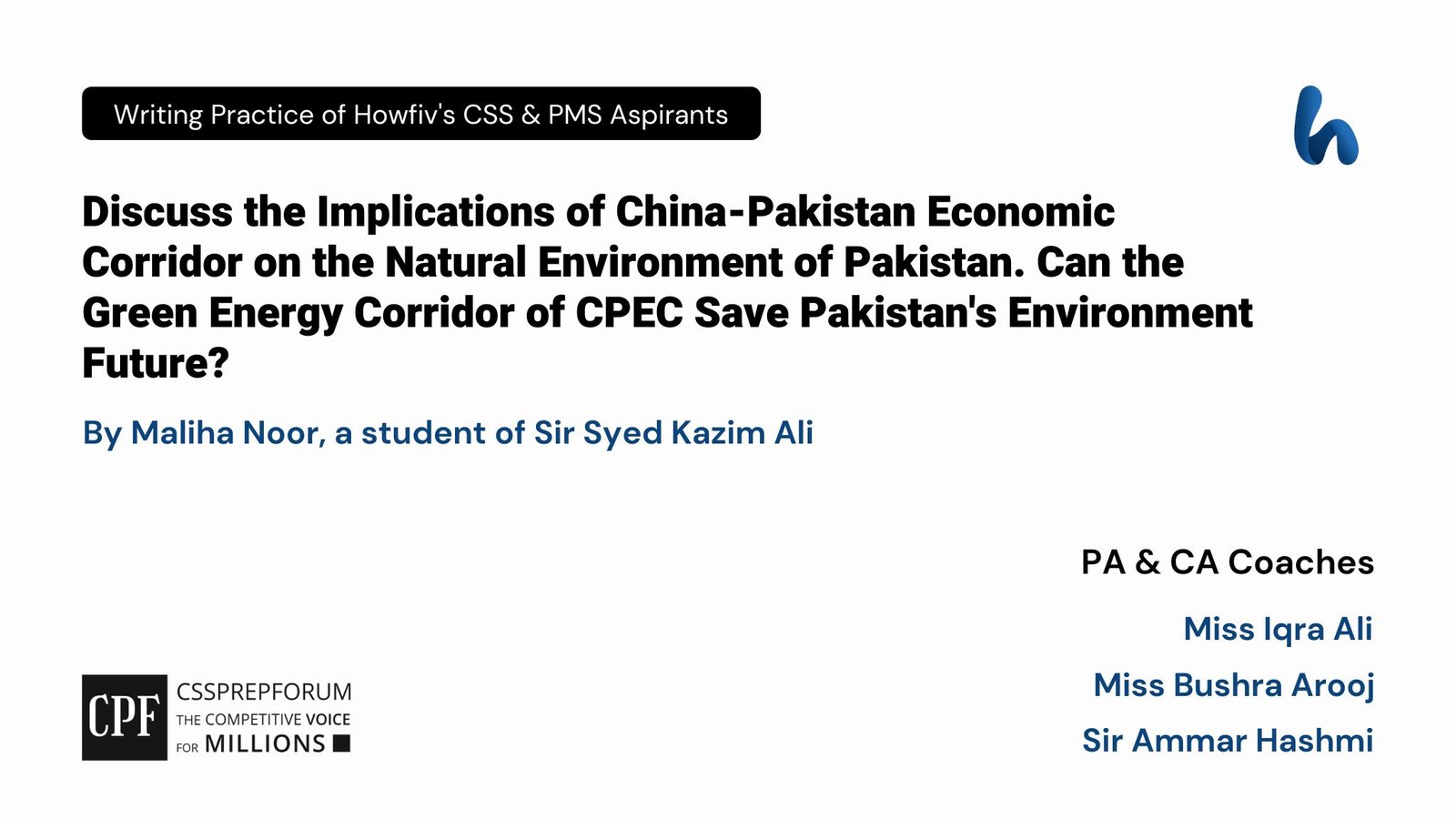The CSS Solved General Science & Ability (GSA) Past Paper 2020 is Solved by Pakistan’s top GSA Coaches, Miss Iqra Ali and Sir Ammar Hashmi. They are the only coaches available in Pakistan who have solved the last 20 years GSA solved papers to help aspirants know how to attempt the paper to score above 80. And they have guided thousands of CSS and PMS aspirants. Both coaches have been known for their teaching methodology and imparting concepts to their students, who scored the highest marks in this subject. At the special request of CSSPrepForum, both coaches have solved the paper.

Question – 02
(A) On 7th April 2012, an Avalanche hit a Pakistan military base in Gayari sector trapping 140 soldiers and civilians under deep snow. What is Avalanche; describe its four types with a focus on the most dangerous type?
Question Breakdown:
In this question, the examiner asked you to throw some light on what is Avalanche. So, you need to start explaining the term directly in your own words. When done, the next step is to write on what are the four main types of the avalanche. Since the examiner wants you to focus on the most dangerous Avalanche, while writing the types, don’t forget to distinguish the most dangerous type with a separate subheading within. Lastly, to score maximum marks, you should also draw schematic diagrams of Avalanches. Remember, in the GSA paper, creativity is the key to making yourself stand out from other aspirants
Answer:
Define Avalanche:
Sliding down large or small size ice pieces due to gravity from snow-capped mountains or hills is called an avalanche. It usually takes place in the winter or spring season. However, the glacier movements may cause avalanches at any time. The primary causes of it are snowfall, metaphoric changes in snowpack, earthquakes, and rain.
Types of Avalanche:
There are four types of Avalanche.
1- Loose Snow Avalanche
Such avalanches originate from a single point from where they spread downhill in an inverted ‘V’ pattern, collecting more snow. They are common on steep slopes and are seen after a fresh snowfall, thus are not very solid.
2- Slab Avalanche: The Most Dangerous Avalanche
Slab avalanches occur when a large block of ice falls down a slope. This happens when the weak layers of ice lying lower down in the snowpack are triggered; it falls down pulling all the layers on the top like a giant slab of snow.
- Why are Slab Avalanches so Dangerous
- a. Slab avalanches account for around 90% of avalanche-related fatalities in the countries.
- b. They reach a high speed in a very short period of time. Even small slab avalanches are capable of destroying forests and small villages in the area.
- c. They have a distinct fracture line. If there is a bonded layer of snow (the slab) on top of a weak layer, they occur.
3- Wet Snow Avalanche
Wet snow avalanches are comprised of snow and water at the beginning. Due to friction, they travel slowly but can pick up speed with ease. They are powerful and can scour boulders, earth, trees, and other vegetation, leaving exposed and often scored ground in the avalanche track.
4- Powder Snow Avalanche
A combination of loose snow and slab avalanches is termed a powder snow avalanche. The bottom half consists of a slab, ice, and air; while the upper half has a cloud of powdered snow. The speed attained by it can cross 190 miles per hour.
(B) What do you understand by Global Wind and Pressure patterns? Also, explain wind and pressure features at higher altitudes.
Question Breakdown:
In the first part of the question, the examiner asked you to explain global wind patterns and global pressure patterns. Since it is quite a wide topic, try to be to the point while attempting the answer. First, focus on writing the wind belts- writing two to three lines for each- starting with the definition of wind. Second, write two to three lines about each pressure belt- starting with the definition of Pressure. In the last portion, write the relation of pressure and wind strength with height as asked in the question. Do not forget to draw diagrams elaborating on wind patterns and pressure patterns as the question is incomplete without them. Remember, in the GSA paper, creativity is the key to making yourself stand out from other aspirants
Answer:
Wind:
The natural movement of air or other gases relative to a planet’s surface is caused by differences in air pressure within our atmosphere-from high-pressure areas to low-pressure areas.
Global Wind Patterns:
Based on the uneven heating of the Earth’s surface-The warm temperature at the equator and cold temperature at the poles, there are four major types of global wind systems.
1- Polar Easterlies:
Polar Easterlies are cold and dry because they are located at high latitudes of 60-90 degrees in the southern and northern hemispheres. They blow from high-pressure areas of polar highs towards low-pressure areas- that is, sink towards the equator.
2- Prevailing Westerlies:
Prevailing Westerlies blow from west to east. They are located at 30-60 degrees latitude in the northern and southern hemispheres. These are steady winds that blow from the high-pressure area in the horse latitude- Regions located at about 30 degrees north and south of the equator- towards the poles
3- Tropical Easterlies:
Tropical Easterlies are located at 0-30 degrees latitude in both hemispheres. They flow from east to west due to the Coriolis Effect- the deviation of wind direction due to the rotation of the earth. The warmer air rises up from the equator and sinks back when it cools down.
4- Inter-tropical Convergence Zone (ITCZ):
Intertropical Convergence Zone- also called Equatorial Convergence Zone- is an area near the equator where the easterly trade winds of both hemispheres converge producing a narrow band of clouds and thunderstorms. The storms are short; however, a large amount of rain I produced from them.

Pressure:
The weight of the column of air above a particular location per unit area is called Air Pressure.
Global Pressure Patterns:
Following are the four pressure belts of the earth’s globe
1- Equatorial Low-Pressure Belts:
An equatorial low-pressure belt exists between 0 to 5 degrees north and south of the Equator. It is called doldrums because there is little and no wind in this belt. It is very hot since sun rays direct hit the region, and the warm air from the equator rises up causing low pressure to develop here.
2- Subtropical High-Pressure Belts:
Subtropical high-pressure belts lie between 30 to 35 degrees North and South of the Equator. The weather is warm and moderate with stable and calm winds. Here, the pressure is high because the air gets cool in the Subtropical region.
3- Sub-polar Low-Pressure Belts:
Sub-polar low-pressure belts exist at about 45 to 60 degrees North and South of the Equator. They are associated with the polar front; thus, the temperature here is low making the zone less distinguishable. Moreover, it is the belt where extratropical cyclonic storms are produced.
4- Polar High-Pressure Belts:
Polar high-pressure belts exist at about 70 to 90 degrees North and South of the Equator-the small region extending to the poles. Here, the cold descending air gives rise to high pressures over the Poles.
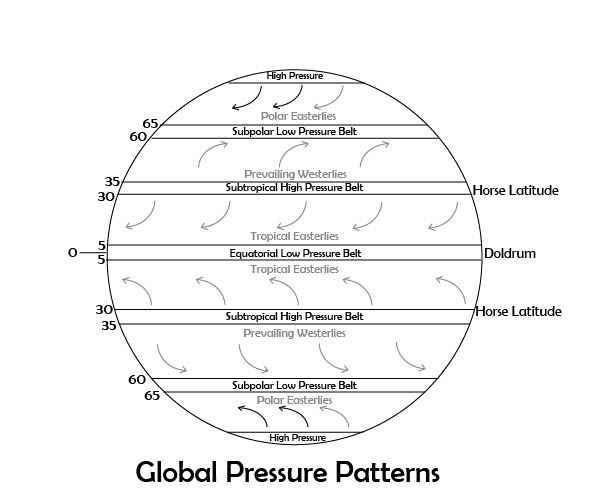
Winds and Pressure Features at High Altitudes:
The atmospheric pressure and altitude are inversely proportional to each other. As the altitude-the distance above sea level- rises, air pressure drops because of two reasons: earth’s gravity and density (the air at heights becomes less dense than air nearer to sea level). Further, the less dense air at higher altitudes makes the wind more powerful with the high speed of air particles.
(C) World’s largest earthquake was assigned a magnitude of 9.5 by the United States Geological Survey on 22 May 1960 in southern Chile Valdivia. What do you know about earthquakes? Also, explain shallow-focus and deep-focus earthquakes.
Question Breakdown:
The question mainly demands your understanding of earthquakes. So, Start your question with the definition and give a brief explanation of earthquakes as concise and relevant as you can. Remember, the first statement is just an exaggeration; thus, ignore it. So, you need to start explaining the term directly in your own words. When done, the next step is to write short notes on the Shallow-focus earthquake and deep-focus earthquake. Attempting the comprehensive definition with an elaborative diagram is more than enough. However, writing a few traits of both individually can help you obtain maximum marks. Last, in the GSA paper, creativity is the key to making yourself stand out from other aspirants
Answer:
Earthquake:
Intense shaking and trembling of the Earth’s surface caused by the sudden forces or movements in its outermost layer are known as an earthquake, a natural disaster.
Formation of Earthquake:
When stress in the crust, the outermost layer of earth, exceeds the strength of the rock, it breaks along the lines of weakness, either a pre-existing or new fault plane.
1- The starting point of an earthquake is termed the hypocenter or focus and maybe hundreds of meters deep within the earth.
2- Similarly, the point at the earth’s surface directly above the focus is called the earthquake epicentre.
Causes of Earthquake:
The most common causes of earthquakes are
1- Fault zones
2- Plate tectonics
3- Volcanic activity
4- Human activities.
Measurement of earthquake:
Since earthquake is exhibited in the form of seismic waves, experts use seismometers to record the seismic waves produced by earthquakes.
Shallow Focus and Deep Focus Earthquakes:
Shallow-Focus Earthquakes:
1- Earthquakes that occur anywhere less than 70 kilometres from the Earth’s surface are called Shallow Focus Earthquakes.
2- They are called crustal earthquakes.
3- They occur quite frequently and at random.
4- The majority of such earthquakes are of smaller magnitude. Therefore, they are often not felt.
5- Though smaller in magnitude, shallow-focus earthquakes pose a greater threat at the surface, as all energy is directed towards a small area.
Deep-Focus Earthquakes:
1- Earthquakes that are deeper than 70 kilometres from the earth’s surface are called deep-focus earthquakes
2- They are often triggered by the collision between plates, hence, they are also known as intraplate earthquakes.
3- They, usually, have high magnitudes like 6 or above.
4- deep-focus earthquakes do not cause much damage as the foci of the quakes to lie at great depths and the energy of the quakes dissipates over a wide area.
5- The strongest deep-focus earthquake ever recorded is of magnitude 8.3, whereas the deepest earthquake is 735.8 km.
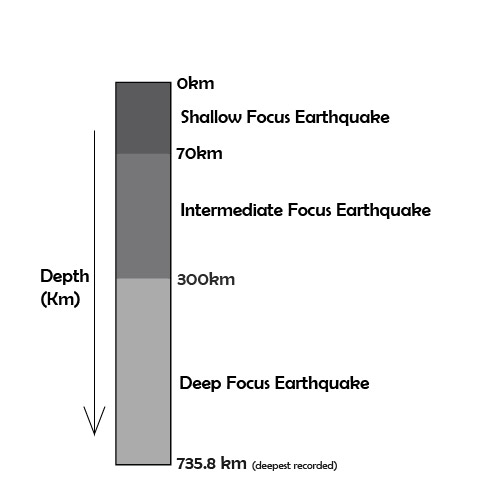
(D) Differentiate between renewable and non-renewable energy sources. Briefly explain Geothermal Energy and Hydro Electricity.
Question Breakdown:
In this question, the examiner has clearly asked you to differentiate between renewable and non-renewable energy resources. Thus, all you have to do is make a table explaining the key differences between both points. Making the third column in the table explaining the names of the traits can make your question look more understandable. In the second part of the question, you are supposed to write brief notes on geothermal energy and Hydroelectricity covering the definition, examples, processes, and occurrence. Writing too much can never grant you maximum marks; however, the way you present your question is the key to obtaining an exceptional grade in your exam.
Answer:
Difference between renewable and non-renewable energy sources:
| Renewable Energy | Non- Renewable Energy | |
| Definition | The sources of energy which on usage can’t be lost forever, but can be recycled and replenished. | The sources of energy which on usage are lost forever, and can’t be recycled and replenished. |
| Biodegradable | Renewable energy sources are eco-friendly and do not cause much pollution in the atmosphere. | Non-renewable energy sources are not eco-friendly and cause a lot of pollution in the atmosphere due to the emission of excessive carbon. |
| Reused and Recycled | These energy sources can easily be reused and recycled. | One cannot reuse and recycle these types of energy resources. |
| Sustainability | These resources are sustainable. | These energy resources are not sustainable instead exhaustible. |
| Cost | The overall cost of these energy sources is high. It required high capital to install and maintain these sources of energy. | The overall cost of these energy sources is not very high, because they can be found naturally. |
| Examples | The five major sources of renewable energy are; solar, wind, hydro, geothermal, and biomass. | The non-renewable resources are; coal, nuclear elements, oil, natural gas, and fossil fuel. |
Geothermal Energy:
✓ Define:
Geothermal energy is the form of renewable energy in which hot water and steam underground the earth is used to drive the turbines to generate electricity.
✓ Occurrence:
Since geothermal energy is produced when the heat is absorbed by water and rocks coming from the highest temperature magma deep down the earth, it is primarily found along major tectonic plate boundaries where most volcanoes are located.
✓ Example:
One of the most active geothermal areas in the world is called the Ring of Fire, which encircles the Pacific Ocean
✓ Process:
To harness geothermal energy, a hydrothermal convection system is used. In this process, a hole is drilled deep under the earth, through which a pipe is inserted. The steam trapped in the rocks is routed through this pipe to the surface of the earth. This steam is then used to turn the blades of a turbine of an electric generator. In another method, the steam is used to heat water from an external source which is then used to rotate the turbine.
Hydro-Electricity:
✓ Define:
Hydroelectricity or hydropower is a source of renewable energy, which uses moving water to generate electricity.
✓ Occurrence:
Hydroelectricity is produced where water is freely available or where water can be utilized via dams. Tidal power is also considered a form of hydropower that is used to generate electricity by using tidal energy, but not widely in use.
✓ Example:
Three Gorges Dam is the biggest hydroelectric power plant in the world.
✓ Process:
For producing power by hydro plants there must be a water reservoir, dam, gate, or valve to control the flow of the water. Because the highest the head from where water flows, the higher potential energy water gains before flowing downwards. During the process of flowing from a higher point to downward water converted its high potential energy into kinetic energy. This water then hits the turbines, which are attached to a generator to produce power.

Question – 03
(A) What are Pesticides? Explain their different types; why persistent pesticides are more lethal for mankind?
Question Breakdown:
The question consists of two parts: an understanding of Pesticides and their types and the reason for the persistent pesticides being lethal to mankind. So, define pesticides in your words with types first based on the pests they kill and second based on their biodegradability to make it link to the second part of the question. In the end, write the reason, for why the persistent pesticide is harmful after defining the term appropriately yet concisely. There is no need to draw any diagram in the question; however, a key explaining the types can be sketched. Remember, in the GSA paper, creativity is the key to making yourself stand out from other aspirants
Answer:
Pesticides:
A pesticide is used to control, repel, or kill certain forms of plant or animal life that are considered to be pests- destructive insect or other animals that attacks crops, food, livestock, etc.
Types of Pesticides:
Pesticides are grouped according to the types of pests which they kill:
Based on the types of Pests They Kill
✓ Insecticides – insects
✓ Herbicides – plants
✓ Rodenticides – rodents (rats & mice)
✓ Bactericides – bacteria
✓ Fungicides – fungi
✓ Larvicides – larvae
Based on how biodegradable they are:
- Biodegradable Pesticides:
Biodegradable pesticides are those kinds of pesticides which can be broken down by microbes and other living beings into harmless compounds.
- Persistent Pesticides:
The persistent pesticides are those pesticides that may take months or years to break down.
Why are persistent pesticides more lethal for mankind?
Persistent pesticides are called persistent because they cannot be degraded by biological systems and environments. They finally reach humans from plants directly or from animals and cause damage to the nervous system, causing tingling, seizures, tremor, and numbness. Pesticides can accumulate in a person’s body over time, but the health effects associated with such exposure are not well defined. People who work with persistent pesticides for a long time have also shown biochemical changes consistent with liver injury.
(B) What are carbohydrates? Classify and give detail of each class along with examples.
Question Breakdown:
In this question, the examiner has simply asked you to define what carbohydrates are so you have to explain the term based on understanding in no more than three to five lines. When done, write down all types of carbohydrates briefly giving one or two examples of each. Drawing the structure of at least one example in each type is what can make you secure maximum marks. However, it cannot memorize, avoid sketching the wrong structure, or your answer might get crossed.
Answer:
Carbohydrates:
Carbohydrates are organic compounds that contain carbon and hydrogen in them. They are also called ‘sugars’ and are the most abundant molecules on the surface of the earth.
General Formula:
Their empirical formula is Cx (H2O)y.
Formation:
Moreover, they are prepared by the photosynthesis process in plants.
6CO2+6H2 O → C6H12 O6+6O2
The process is taken place in the presence of sunlight and chlorophyll. Glucose is obtained as a byproduct.
Classification:
Carbohydrates are classified into three types.
1- Monosaccharides:
These are the simplest sugars that cannot be further hydrolyzed. They contain 3 to 9 carbon atoms. Hence, their classification is based on the number of carbon atoms e.g. trioses, tetroses, hexoses, pentoses etc.
For example:
Glucose and fructose are examples of Monosaccharides.
2- Oligosaccharides:
Oligosaccharides contain 2 to 9 units of Monosaccharides that can be further hydrolyzed. Hence, their classification is based on the number of units on hydrolysis e.g. disaccharides, trisaccharides, tetra-saccharides etc.
For example:
Sucrose is an example of oligosaccharides. In the presence of dilute HCL and by providing the heat sucrose is converted into glucose and fructose on hydrolysis.

3- Polysaccharides:
Polysaccharides are macromolecules that consist of hundreds and thousands of monosaccharides.
For example:
Starch and cellulose are examples of polysaccharides.

(C) Discuss different methods of food preservation.
Question Breakdown:
The question is as simple as it appears. All you have to do is write down different methods for food preservation. Since you know the question contains five marks, briefing any five methods with and understanding can help you get full marks. However, make sure to always initiate your question by explaining the main jargon of your question in one or two lines so that your question may look more appealing. Remember, creativity is what makes your GSA paper stand out among thousands of aspirants.
Answer:
Food Preservation:
Food preservation is the technique that is used to prevent food from spoilage, poisoning, and microbial contamination for a long time.
Methods of Food Preservation:
Some methods for the preservation of food are
1- Freezing:
In this method, the temperature of the food items is lowered by placing them in cold storage which helps in preventing the growth of micro-organisms, like bacteria and fungi. Fish is usually transported from Karachi to other cities by placing ice cubes in their storage.
2- Vacuum Packing:
In this method, food items are placed in a plastic bag. And the vacuum is created in the bag by removing the air containing oxygen and co2- the essential requirements for the growth of Bacteria. It results in the death of microorganisms. This method is usually used for the preservation of dry fruits- the best source of food for astronauts.
3- Salting:
The method implies the use of edible salt thrown over the food items. It, not only slowdowns the nourishment of Bacteria but also deactivates the enzyme present in the tissues. Meat in farsighted areas where there is no light and other techniques of preserving food is not applicable.
4- Canning and bottling:
In this method, the, already, cooked food items are restored in cans and bottles made sterile by burning or washing them with different sterling agents. The food items are safe till the cans and bottles are sealed. The partially cooked pulses are, usually, stored with the help of this method.
5- Burying in the ground:
Food items are buried in the ground with no light, oxygen, and Carbon dioxide. This hampers the growth of microorganisms. It is commonly used to preserve vegetables, like potatoes.
(D) Where and how Fiber Optics is used? Also, write down their advantages and disadvantages.
Question Breakdown:
In the first part of the question, the examiner has asked you to explain optical fibres, their uses, and the mechanism involved in them. So write step-wise by initiating with the definition of optical fibres. Then, write a very comprehensive mechanism of working, and a few uses- not explaining them too much- and move to the second part of the question, i.e., writing any five advantages followed by the five disadvantages. Keep in mind not to write too much in your GSA paper since the question contains no more than five marks. The more the parts of the question become, the less get their weightage. Hence, your question must be concise and complete at the same time.
Answer:
Define:
Fibre optics is a bundle of thin strands made of glass or plastic, which uses light (photon particles) to transmit signals. Therefore, the transmission capacity of fibre optic is far greater than other modes of communication, such as copper wire and metallic wires. As a result, it is used in the form of different cables and is being utilized in numerous fields of life.
How does Fiber-Optics work?
The propagation of light in an optical fibre requires that light should be totally confined within the fibre and not escape from it. This can be done by
✓ Total internal reflection
✓ Continuous Refraction
Since light rays travel in straight lines, optical cables are designed in a way that they bend all the light rays inwards. Light rays travel continuously, bouncing off the optical fibre walls and transmitting end-to-end data. Although light signals do degrade over progressing distances, depending on the purity of the material used, the loss is much less compared to using metal cables.

Uses of Optical Fibres:
Following are a few uses of optical Fibre:
✓ Used for Telecommunication for transmitting and receiving purposes
✓ Used in medical devices to view internal body parts
✓ Used to transmit images
✓ Used in wirings in aircraft, hydrophones for SONARs and Seismics applications.
Advantages and Disadvantages of Optical Fibers
The advantages of optical fibre are as follows.
- The bandwidth of optical fibres is higher than copper wires.
- Optical fibres have fewer power losses, and data can be transmitted for much longer distances.
- The optical fibre cables are resistant to electromagnetic interference.
- Since the weight of optical fibre cables is less, their Installation is relatively easy.
- Fibre optic cables are very flexible and oppose most acidic elements that hit the copper wire.
The disadvantages of optical fibre include
- Optical fibre cables are expensive to install.
- The optical fibre cables are very difficult to merge, and there will be a loss of the beam within the cable while scattering.
- The Optical fibre cables require special test equipment before installation.
- Since fibre optic cables are compact, they are more vulnerable than copper wires.
- In optical fibres, transmission requires repeating at distant intervals.

Question – 04
(A) Briefly describe the various segments of the atmosphere. How these segments are maintaining the Earth Radiation Balance?
Question Breakdown:
This question has mainly two parts. In the first part, the examiner has asked you to describe the segments of the atmosphere in a brief manner. First, start your answer by defining the atmosphere. When done, write down the names of segments along with their explanation briefly. Also, draw a diagram to score maximum marks. When done, move towards the next segment in which the examiner has asked you to mention the ways of the maintenance of Earth radiation balance in relation to these segments. First of all, define what the Earth’s Radiation balance actually is then write down its ways of maintenance briefly. Lastly, remember that creativity is what will award you maximum marks on your GSA paper.
Answer:
What is Atmosphere?
The layers of gases around the earth are called the Atmosphere. In other words, an atmosphere contains the air that we breathe and is a blanket of gases that surrounds Earth. Moreover, it is held near the surface of the planet by Earth’s gravitational attraction.
Based on its temperature, the atmosphere can be categorized into 6 segments.
1- Troposphere:
The bottom-most layer of the atmosphere where we live in the troposphere. It extends upward to about 10km above sea level starting from the ground level. It comprises 75% of all air in the atmosphere; its lowest part is known as the boundary layer while the topmost layer is called the tropopause.
2- Stratosphere:
Above the troposphere lies the stratosphere. Its distance from the surface of the earth is 12 -50 Km. The ozone layer lies in the stratosphere; the stratosphere is the layer where aeroplanes fly.
3- Mesosphere:
The layer of ions is Mesosphere. It extends to a height of about 85km from the ground level.
4- Thermosphere:
The topmost layer of the strata of the atmosphere is the thermosphere. Its distance from the earth’s surface is 80-320 Km. Satellites orbit Earth within the thermosphere.
5- Exosphere:
The pseudo or false atmosphere above 500 km is the exosphere. It is the final frontier of the Earth’s gaseous envelope. The exosphere is 10, 000 km from the earth’s surface. However, there’s no clear-cut upper boundary where it finally fades away into the space.
6- Ionosphere:
The ionosphere is an abundant layer of electrons and ionized atoms and molecules that stretches from about 48 kilometres (30 miles) above the surface to the edge of space at about 965 km (600 mi), overlapping the mesosphere and thermosphere. This region is what makes radio communications possible.
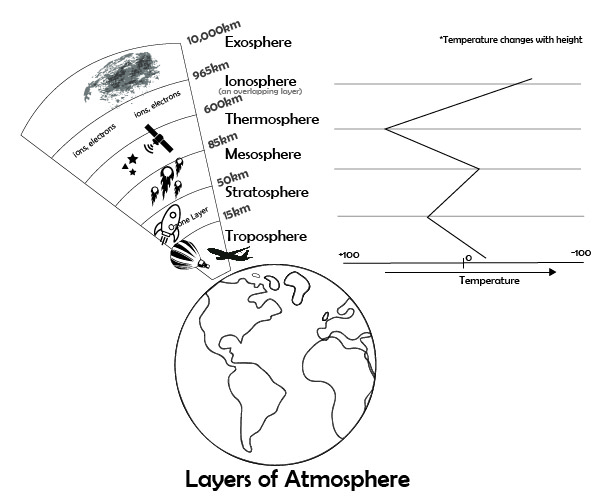
How these segments are maintaining Earth’s radiation balance?
To understand this part of the question, it is pertinent to first know what is meant by Earth radiation balance? The radiation balance of Earth is the algebraic sum of the incoming and outgoing components of radiation. The energy which is released as shortwave light and UV radiation from the Sun reflect back to space in a shorter portion as much of this energy is absorbed by the surface of Earth and some of it is absorbed in the clouds.
Moreover, the atmospheric segments (layers) play a crucial role in maintaining the heat balance on Earth because the ozone molecules present in the stratosphere absorb high-energy ultraviolet radiations (UVB & UVC) coming from the sun and they convert it into both atomic and diatomic oxygen. That is why the temperature starts increasing gradually in this layer with the increasing altitude. Also, atomic oxygen is found in a huge amount in the upper part of the stratosphere due to the breakdown of ultraviolet radiations and also the destruction of diatomic oxygen. It is when these two forms of oxygen recombine and form the ozone molecules, there releases a prevalent amount of heat because of which the temperature is high in this layer. In other words, it would be sound to say that the Earth is protected from UV rays and IR radiations due to the ozone layer present in the stratosphere.
(B) How the organic particulate matter enters the atmosphere. Also, describe the sources?
Question Breakdown:
In the first part of the question, the examiner has asked you to describe the ways organic particulate matter enters the atmosphere and its sources. First, start your answer with a description of organic particulate matter briefly in your own words. When done, write down the ways how it goes in the atmosphere. Moreover, explain its sources as asked in the second part in bullet form. Lastly, you do not need to draw any diagram for this question.
Answer:
Organic Particulate Matter:
Organic particulate matter is particulate matter that is composed of carbonaceous and other organic substances. It is basically a complex mixture of some liquid droplets present in the air, consisting of a variety of components such as metals, acids, and organic compounds. Organic particulate matter is a major cause of air pollution.
Sources of organic particulate matter:
1- Diesel engines
2- Wood smoke
3- Gasoline engines
4- Paved road dust
5- Gaseous precursors
How does it enter the atmosphere?
There are two ways in which organic particulate matter enters the atmosphere:
a. Direct way or Primary Source
b. Indirect way or Secondary Source
Primary source or direct way:
The organic particulates enter the atmosphere directly through:
✓ It directly emits carbonaceous compounds in the air and the organic particulate matter gets into the atmosphere.
✓ The release of certain gases from solid waste also results in the emission of organic matter into the atmosphere.
✓ The release of chlorofluorocarbons (CFCs) into the air
✓ The release of carbon dioxide (CO2), sulphur dioxide (SO2), carbon monoxide (CO), and nitrogen oxide (NO2) in the air
Secondary Source or Indirect way:
The already suspended harmful gases and substances in the air when combined with each other or other air pollutants of organic nature they form organic particulate matter in the atmosphere. Moreover, the condensation of oxidation products of certain volatile organic compounds also forms organic particulates in the air.
For example:
✓ Acid Rain is a combination of CO2 and H2O forming carbonic compounds in the air.
✓ The formation of smog when smoke (having carbon particles) combines with fog.
✓ Volatile organic compounds are those compounds that catch fire and result in fumes. These fumes when combined with oxides of nitrogen, they release chemical compounds and molecules of ozone.
(C) What is natural radioactivity? How is it different from artificial radioactivity?
Question Breakdown:
In the first part of this question, the examiner has asked you to describe the two terms- Natural & artificial radioactivity briefly. So, start your answer by defining both terms briefly in your own words. When done, move towards the next part of the question and write down the main differences between natural and artificial radioactivity. Not to speak of that, writing these differences in table form is what will award you maximum marks in your GSA paper. Lastly, you do not need to draw any diagram for this question.
Answer:
Natural Radioactivity:
There are certain substances having unstable nuclei, called radioactive elements, such as uranium. It is a process in which the nucleus of an atom of radioactive elements undergoes spontaneous and uncontrollable disintegration (or decay) and emits alpha, beta, and gamma rays. The process of emitting these rays is called radioactivity of the elements and rays emitting are called radioactive rays. Therefore, natural radioactivity is the spontaneous disintegration of the nuclei of heavy (radioactive) elements with the emission of radiation.
Artificial Radioactivity:
Induced radioactivity, man-made or artificial radioactivity, is a process that converts stable elements to unstable elements by bombarding them with appropriate atomic projections like alpha, beta, and gamma.
Example: alpha = helium nucleus whose mass number is 4 and nuclear charge (atomic number) is +2.
| Characteristics | Natural radioactivity | Artificial radioactivity |
| Definition | Nuclear reactions occur spontaneously and emit radioactive rays, called natural radioactivity. | It’s man-made radioactivity that is used to convert stable elements to unstable elements by bombarding alpha beta gamma rays. |
| Reactants | Single reactant | Involve a chemical element and an initiating particle |
| Reactant type | Fusion reaction | Fission reaction |
| Example | Fusion in the core of the sun | Fission in heavy machinery |
(D) What are the Fossils? Discuss the importance of palaeontology.
Question Breakdown:
In the first part of the question, the examiner has asked you to describe fossils. Thus, start your answer by defining the term briefly in your own words. When done, move towards the next part of the question which is the importance of palaeontology. First, write down the definition of the term in your own words. When done, explain its importance. Additionally, write down its importance in bullet form to make your paper stand out from other aspirants. Lastly, you do not need to draw any diagram for this question.
Answer:
Fossils:
Fossils are the preserved remains, or traces of remains, of ancient organisms. Fossils are not the remains of the organism itself: they are rocks. A fossil can preserve an entire organism or just part of one. Bones, shells, feathers, and leaves can all become fossils.
Importance of Paleontology:
While many people write off palaeontology as just another branch of science, few realize its true significance.
- The information provided by palaeontologists can offer clues about the modern climate. This data may prove vital in the efforts to undo the damage caused by human actions.
- Palaeontology helps us to track the changes to the ecosystems around us. Further, it helps us to better understand exactly what elements are changing in our ecosystems and what leads to those changes.
- Conservation of modern life requires understanding the life forms of the past.
- In fact, no other branch of science can offer the amount of data regarding change over time.
- Palaeontology is foundational to dozens of other scientific fields. Palaeontology is a gateway science.
- Children that take an early interest in learning often go on to exhibit intellect later in life.

Question – 05
(A) What do you know about Hepatitis? Describe its types and write down preventive measures.
Question Breakdown:
The question has three parts. In the first part of this question, the examiner has asked you to explain hepatitis. So, write down its definition causes and symptoms briefly to score maximum marks. Remember, whenever the examiner asks you to describe what you know about the term, you have to write down its cause/symptoms etc., along with its definition. When done, move towards the next part and write down its types with subheadings and bullets. Finally, write down all the possible preventive measures in bullet points. Lastly, you do not need to draw any diagram for this question.
Answer:
Hepatitis:
Hepatitis refers to an inflammatory condition of the liver.
Causes of Hepatitis:
Primarily, it is a viral disease. However, sometimes medication, drugs, toxins, and alcohol are also responsible for the autoimmune hepatitis-a disease that occurs when a human body makes antibodies against liver tissues.
Symptoms of Hepatitis:
Some of the common symptoms of hepatitis are fatigue, loss of appetite, high fever, nausea, vomiting and abdominal pain.
Types of Hepatitis
Hepatitis is mainly classified into five categories Hepatitis A, Hepatitis B, Hepatitis C, Hepatitis D, and Hepatitis E, among which the first three are better known.
1- Hepatitis A:
a. Hepatitis A was formerly called Infectious Hepatitis.
b. Hepatitis A is a mild viral liver disease caused by a non-enveloped RNA virus.
c. It is transmitted through ingestion of contaminated food and water or through direct contact with an infected person.
d. Its epidemics can be explosive and cause substantial human and economic loss.
e. Almost everyone infected with hepatitis A recovers fully with lifelong immunity. However, a very small proportion of hepatitis A patients die from it.
–Preventive Measures for Hepatitis A:
Vaccines for hepatitis A are available. Moreover, safe water supply, food safety, improved sanitation, and regularly washing hands are the most effective ways to combat the disease.
2- Hepatitis B:
a. Hepatitis B virus was formerly called serum Hepatitis.
b. Hepatitis B varies from acute to chronic liver disease and is caused by a DNA virus.
c. The virus is mostly transmitted to a person through contact with the blood or other body fluid of an infected person.
d. An estimated 240 million people are chronically infected with hepatitis B. More than 700,000 people die every year due to complications of hepatitis B. Besides, it also causes cirrhosis (liver fibrosis or dysfunctional liver) and liver cancer.
e. It is a major occupational hazard for health workers.
–Preventive Measures for Hepatitis B:
It can be prevented by currently available vaccines. Moreover, avoiding using syringes, safe sex practices, and implementing blood safety strategies can help in the prevention of Hepatitis B.
3- Hepatitis C:
a. Hepatitis C was formerly called non-A non-B Hepatitis.
b. Like hepatitis B, hepatitis C virus is also an acute to chronic hepatitis infection caused by RNA enveloped virus.
c. It is a blood-borne disease that is mostly transmitted through unsafe injection practice, inadequate sterilization of medical equipment, the transfusion of unscreened blood and blood products, unsafe sex, and from an infected mother to her baby.
d. A significant number of those who are chronically infected will develop liver cirrhosis or liver cancer.
e. Globally, between 130-150million people, have chronic hepatitis C infection, and approximately 700,000 people die from hepatitis C-related liver diseases.
–Preventive Measures for Hepatitis C:
Currently, there is no vaccine available for hepatitis C. However, implementing blood safety strategies, such as quality assured screening of all donated blood, can help prevent the transmission of hepatitis C. Similarly, safe sex practices and proper disposal of used syringes can be effective strategies to protect against transmission.
(B) Differentiate between Middle Latitude Cyclones and Tornadoes.
Question Breakdown:
In this question, the examiner has asked you to write down the main differences between mid-latitude cyclones and tornadoes. To make yourself stand out in the paper, write down the differences in table form that too on the basis of their definitions, formation, rotation, measuring scale as well as diameter, circumstances, and duration. Remember, in the GSA paper, creativity is the key to scoring maximum marks. Lastly, you do not need to draw any diagram for this question.
Answer:
| Characteristics | Mid-latitude Cyclones | Tornadoes |
| Define | Middle latitude cyclone is a type of storm, formed in middle latitude, characterized by rapidly swirling air masses around a low-pressure core, which results in stormy and often destructive weather | A tornado is a small but intense vortex of a spinning column of air that extends between the earth’s surface and a cloud. |
| Formation | Middle-latitude cyclones are the result of the dynamic interaction of warm tropical and cold polar air masses at the polar front. | Tornadoes form when warm, humid air collides with cold, dry air. |
| Rotation | Clockwise in the southern hemisphere and counterclockwise in the northern hemisphere. | It also has the same rotation in both the hemispheres. |
| Measuring Scale | The scale for measuring cyclones is called the Beaufort Scale and Saffir-Simpson scale. | The scale used for rating the strength of tornadoes is called the Fujita (F) and Enhanced Fujita (EF) Scale. |
| Circumference | They have a wide circumference. | They have a small circumference. |
| Diameter | Diameter 200km | Diameter 300_400 yards |
| Duration | They last for 3 to 10 Days. | They last for less than 10 minutes. |
(C) What is Open System Interconnections (OSI) and describe its layers?
Question Breakdown:
The question has two parts. In the first part, the examiner has asked you to explain Open System Interconnections (OSI). So, start your answer with its description briefly in your own words. In the next part, describe the layers of OSI in ascending order from the lowest layer to the uppermost one. Writing down a little bit of explanation about each layer along with their functions is what will award you maximum marks in your GSA paper. Lastly, in this question, there’s no need to draw any diagram.
Answer:
Open System Interconnections- OSI:
Open system interconnection is a reference model for how applications communicate over a network. The model focuses on providing a visual design of each communication layer built on top of the other, starting with the physical cabling, all the way to the application that’s trying to communicate with other devices on a network.
Layers of OSI:
According to the standard OSI Model, there are seven layers. Each layer is dependent upon the layers below it to function.
Layer 7: Application layer:
The application layer enables the user- human or software- to interact with the application or network whenever the user elects to read messages, transfer files or perform other network-related tasks. Web browsers and other internet-connected apps such as Outlook and Skype use Layer 7 application protocols.
Layer 6: Presentation layer:
The presentation layer is responsible for the proper translation to interpret a message sent through the network properly. The layer is also responsible for the encryption and decryption that the application layer requires.
Layer 5: Session layer:
The session layer is responsible for request or response communication. When required, a session is started with authentication, and then a request is sent. The response is a signal that the session might end, or a new request may be sent. This is the first layer where a client/server concept is introduced.
Layer 4: Transport layer
The Transport Layer ensures the reliability and quality of a system. The layer also controls traffic flow via the network layer and checks errors guaranteeing the quality of service by resending data after data has been corrupted.
Layer 3: Network layer
The Network Layer ensures the coordination of related parts of a data conversation so that large files can be transferred. Stating differently, the network layer organizes the data for transfer and reassembly that is transferred using the data link layer method. This layer also handles aspects of Routing Protocols, finding the available [best] path(s) from one network to another to ensure delivery of the data.
Layer 2: Data link layer
Data Layer mainly links information from the network to the physical layer by breaking data into frames. Some error detection and correction are also done in this layer.
Layer 1: Physical layer
The physical layer deals with the physical as well as an electrical portion of devices that explains how a device sends or receives signals via copper wires or optical fibres. Additionally, the layer converts signals into a compatible form that the next layer can use-a bit- and adjusts them to allow multiple users to use the same connections.
For Example:
-Ethernet or fibre optic cables
-Phone cords used for dial-up or DSL services
-Coaxial cable is used to provide broadband internet etc.
(D) What is GPS? How does it work?
Question Breakdown:
The question has two parts. In the first part, the examiner has asked you to briefly describe the Global Positioning System (GPS). So, start your answer with its definition in your own words. When done, move towards the next part which is about the working of GPS. Explain its working alongside the segments which are responsible for its working. Lastly, you do not need to draw any diagram for this question.
Answer:
Global Positioning System:
Geo Positioning System, GPS, is a space-based navigation technology that provides the pinpoint location, velocity, and time-24 hours a day- of anything on the earth with ultra-high accuracy. Although the GPS project has been started by the US Defense Department in 1973 for military operations, it has not been in the mainstream until 2007.
Working of GPS:
Mainly, the GPS has three fundamental segments:
-Satellites
-Receivers
-Control systems
Almost 31 satellites orbit around the earth at different angles collecting data from all over the earth, they continuously emit radio signals. In response to the approaching signals, the portable receivers, for instance, your mobile phones become active and measure the time and location of the satellites. The distance is then measured by triangulation, tri referring to three, as three minimum satellites are always required to produce accurate signals. Meanwhile, the control systems are responsible for the proper functioning of the entire GPS by tracking, controlling, and communicating with the satellites.
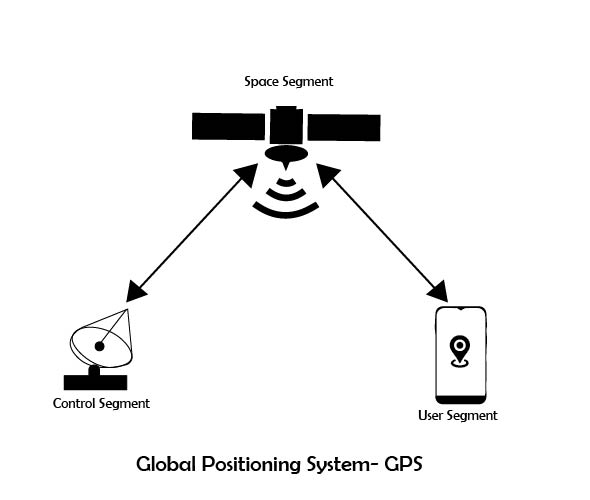
Writing meaningful sentences, lines, paragraphs, and blogging helps children maintain positivity, sharpen their intellect, and think purposefully. Let’s get your kid(s) registered & turn him a youngest blogger!
Kids Online Writing Course

Question – 06
(A) Tariq can do a tailoring job in 6 hours. Sajid does the same job in 4 hours. Irfan does it in 8 hours. Tariq and Sajid start doing the work. Sajid leaves after two hours and Irfan replaces him. How long would it take to complete the work?
Answers:
Time taken by Tariq = 6 hours
Time taken by Sajid= 4 hrs
Time taken by Irfan = 8 hrs
Together, Tariq and Sajid can do the job in
1/T = 1/6 + ¼
After taking LCM
1/T= 5/12
So, if we reverse the equation it becomes
T = 12/5 = 2.4 hrs
Likewise, Tariq and Irfan can do the job in:
1/T= 1/6 + 1/8
1/T = 7/24
T = 24/7 = 3.42 hrs
Work completed by Tariq & Sajid in two hours:
= 100 x 2/2.4
= 83.33 %
Remaining work= 100 – 83.33 = 16.66 %
Therefore, the time taken by Tariq and Irfan to complete the remaining work will be:
= 3.42 x 16.66/100
= 0.569
Hence, the total time taken in completing the work is:
2 + 0.569 = 2.569 hrs
= 2.57 hrs.
(B) Find the missing number to complete each sum
(a) 9 + 8 – 5 = 2 x (–)
(b) 3 x 9 – 14 = 24 – (–)
(c) 15 – 3 x 12 = 41 + (–)
(d) 24 – 4 – 5 = 66 – (–)
(e) 8 * 6 – 10 + 3 – 7 = 6 – (–)
Answer:
a. 9+8-5= 2x
Let suppose missing number as Y so,
9+8-5= 2 x Y equation (a)
Now solve the question with BODMAS rule:
9+8-5= 2Y
17-5=2Y
12=2Y
Y= 12/2 = 6
So, the missing number is 6.
For verification, put the value of Y in equation (a)
9+8-5= 2Y
9+8-5= 2 x 6
9+8-5= 12
17-5= 12
12=12
Hence, Left side = right side
b. 3×9-14= 24 – (……)
Let’s suppose missing number as X
3×9-14= 24 – X Equation (a)
Now, by Using BODMAS rule:
3×9-14= 24 – X
27-14 = 24 -x
13 = 24 –x
By changing sides to get the value of X
X = 24 – 13
X = 11
So, the missing number is 11.
For verification, putting the value of X in equation (a):
3×9-14= 24 – x
3×9-14= 24 – 11
27 – 14 = 24-11
13 = 13
Hence, Left side = right side
c. 15÷3×12= 41+ (…..)
Let suppose missing number as X so,
15÷3×12= 41+ X equation (a)
By Using BODMAS rule:
15÷3×12= 41+ x
5 x 12 = 41 + x
60 = 41 + x
X = 60 -41 = 19
X = 19
So, the missing number is 19.
For verification, putting the value of X in equation (a):
15÷3×12= 41+ 19
5 x 12 = 41 + 19
60 = 60
Hence, Left side = right side
d. 24÷4 +5= 66÷ (…..)
Let suppose missing number as X so,
24÷4 +5= 66 ÷ X equation (a)
By using BODMAS rule:
24÷4 +5= 66 ÷ X
6 +5 = 66/X
11 = 66/X
X = 66/11 = 6
X = 6
So, the missing number is 6.
For verification, putting the value of X in equation (a)
24÷4 +5= 66 ÷ 6
6 +5 = 11
11 = 11
Hence, Left side = right side
e. 8×6-13+3= 7×6- (……)
Let the missing number be X so,
8×6-13+3= 7×6- X equation (a)
By Using BODMAS rule:
8×6-13+3= 7×6 – X
48-13+3 = 42 – X
35 +3 = 42 – X
38 = 42 – X
X = 42 – 38
X = 4
So, the missing number is 4.
Now for verification, putting value of x in equation (a):
8×6-13+3= 7×6- 4
48-13+3 = 42 -4
35 +3 = 38
38 =38
Hence, Left side = right side
(C) There are seven students in a group having ages 17,17,18,18,18,19,19. Calculate the mean, median, mode and range of their ages. Also, define these mentioned terms.
Answer:
What is Mean?
The mean is defined as, the sum of the values divided by the number of values.
Mean = sum of all values/ total number of values
Sum of all values= 17+17+18+18+18+19+19=126
Total number of values=7
Mean = 126/7
= 18
Thus, the mean is 18
What is the median?
The middle value of an arranged data set is called the median. Here, arranged data means writing all the values in ascending order. The given values are already in ascending order i.e.,
17,17,18,18,18,19,19
For an odd number of entities, ((𝑛+1)/2)^𝑡ℎ term, where n is the total number of entities.
thus, ((7+1)/2)th term = 4th term = 18
Median= 16
What is the mode?
The mode is the most repeated value in a data set. The most repeated value in the above-mentioned data is 18.
Hence, the mode is 18.
What is Range?
The range can be defined as the difference between the largest value and the smallest value.
In the above-given data, the largest value is 19, and the smallest value is 17. Hence, the range can be calculated as:
Range = 19 – 17 = 2
Thus, the Range is 2.
(D) How do mental ability scales differ from IQ test?
Answer:
- What is meant by the term mental ability scales?
Scales that measure specific constructs like numerical ability, mental fitness, and verbal ability, mathematical and spatial ability are known as mental ability scales.
- What is meant by IQ?
IQ, or intelligence quotient, is essentially a measurement of a person’s general intelligence and raw intellect in relation to the average intelligence score of other people.
| Mental ability scales | Intelligence quotient ( IQ) test |
| Mental ability scales can measure specific areas of intelligence/abilities of a person. | IQ measures the general intelligence of a person in comparison with other people. |
| In mental ability, age is not a factor. | To determine IQ score, age is required. So, here age is a factor. |
| There is a separate score for each category | Here, there is only one single score as a whole. |
| Highly predictive of job performance | Moderately predictive of job performance. |
| The most common use of the mental ability scale is pre-employment testing | Research & education are the most common uses of IQ tests. |
Question – 07
(A) Mushtaq, Pervaiz, Ehsan, Umair and Saleem are friends having different heights and weights. Mushtaq weighs four times as much as Pervaiz and Pervaiz weigh double than Ehsan. Ehsan weighs half as much as Umair and Umair weigh half as much as Saleem.
(i) Who is the heaviest among five friends?
(ii) Who is the second heaviest?
(iii) Who has the lowest weight?
(iv) Who are equal in weight?
(v) Mention the descending order.
Answer:
According to the given scenario, we can write
Weight of Mushtaq= M
Weight of Ahsan= A
Weight of Saleem= S
Weight of Pervez= P
Weight of Umair= U
After applying the condition given, we have:
M= 4P
P= 2A
A= ½ U
U= Half S
Now, let’s assume that the weight of Pervez(P) is 25kg. Then we get the values of M, A, S, and U as follows:
M= 4P= 4(25)= 100
P= 2A
A= P/2= 25/2= 12.5
A= ½ U
U= 2A= 2(12.5)= 25
U= half S= 1/2S
S= 2U= 2(25)= 50
Thus, we can conclude that:
Mushtaq is the heaviest of them all with a weight of 100 kg.
Saleem is the second heaviest with 50 kg.
Ahsan has the lowest weight 12.5 kg.
Pervez and Umair are equal in weight 25kg.
So, the descending order would be:
Mushtaq ≥ Saleem ≥ Pervez & Umair ≥ Ahsan
(B) A farmer needs to build a boundary wall around his farm. If the area of the farm is 484 m2, what will be the total area of the wall if it is two meters high on three sides and three meters high on one side?
Answer:
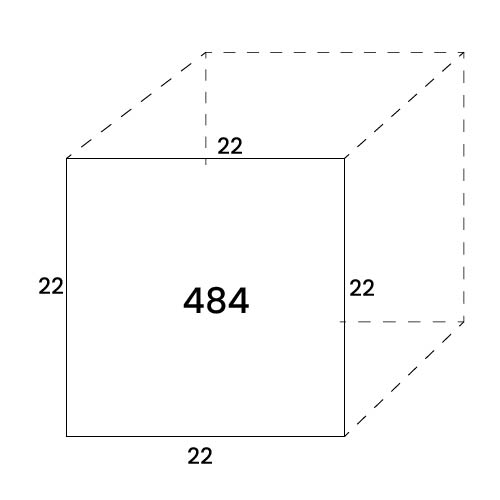
We know that a rectangular shape
A= b x h
Now we know the height, but we first need to have a base to move forward. Thus, to find the base, they have given us the area of form which is 484 m². Prime Factorization or taking the square root of this area we get 22 which is the base for each wall.
Now, for the area for 3 sides of equal heights we get:
22 x 2×3 = 132
And for the last height = 22x 3= 66
Total area= 132+66= 198 m²
Hence, the total area of the wall is 198m².
(C) Five girls A, B, C, D, E and four boys W, X, Y, Z have to go on a trip in three cars car-1, car-2 and car-3. The following restrictions for seating in the car are to be observed
(i) Only three persons can sit in one car
(ii) At least one boy and one girl must be in each car
(iii) A and D should remain together
(iv) Z cannot sit with B or C in the same car
Distribute boys and girls in three cars.
Answer:
Keeping all the restrictions and mentioned rules un-mind, the distribution can be done in many ways. Here are 3 ways to distribute them in 3 cars:
Way1:
Car A= A, D, Z
Car B= B, C, X
Car C= E, W, Y
Way2:
Car A= A, D, W
Car B= B, C, Y
Car C= E, Z, X
WAY3:
Car A= A, D, X
Car B= E, Y, Z
Car C= B, C, W
(D) What are social skills? Describe 4 causes of weak social skills.
Answer:
What is meant by social skills?
Social skills are those goal-directed skills that one uses for communicating and interacting with each other, both verbally and non-verbally. They are used through gestures, body language and the personal appearance of a person. Different social skills are used for professional as well as for personal communication.
Types of social skills:
1- Verbal communication:
It is the most important and obvious of all the social skills. It is the most basic part of socially interacting with other people.
2- Non-verbal communication:
While verbal communication is an important skill, so is non-verbally through one’s body language, eye contact, and gestures. One can show a diverse range of emotions without speaking. i.e., If you are walking around with a smile on your face, it will help you in engaging with other people more easily.
3- Collaboration and cooperation:
It is another very important social skill because it helps you a lot while doing teamwork.
4- Listening:
One needs to listen carefully in order to respond properly. People respond well to others when they are sure that they are being heard in a proper way. Therefore, it is also one of the most important types of social skills.
Question – 08
(A) What do you understand by the term systematic sampling? Discuss its types.
Answer:
Systematic Sampling:
The statistical probability sampling method where a random sample is taken from a larger population in accordance with a random sampling point but a fixed periodic interval is known as systematic sampling. The fixed periodic interval, which is known as the sampling interval, is calculated by dividing the population size by its desired sample size.
Types of systematic sampling:
1- Systematic random sampling:
In this type of systematic sampling, samples are selected at a pre-specified interval. Sampling intervals are repeated in this type of systematic sampling.
2- Linear systematic sampling:
In this type of sampling, the entire population is first arranged in a given sequence. After this, the sample size, as well as the sampling interval, is calculated. Lastly, finding a random number and then adding the calculated interval to that random number is what gives you the linear systematic sampling. Here, systematic sampling is not repeated.
3- Circular systematic sampling:
Here, samples are created from the total population. In this type of sampling, the start and end points are not distinct and it restarts from the endpoint.
(B) Blood groups of inhabitants of a village were checked. It was found that 600 people possessed blood group A, 650 possessed blood group B, 550 had blood group AB and 200 have blood group O. Calculate the probability of having blood group B. (ii) Calculate the probability of having blood group O.
Answer:
People with blood group A= 600
People with blood group B= 650
People with blood group AB= 550
People with blood group O= 200
Now, we know that:
P= no of favourable chances (nF)/total no of chances
Total number of chances= 600+650+550+200
= 2000
Now, by putting the values in the formula:
P (B) = 650/2000 = 65/200
= 13/40= 0.325
P (O) = 200/2000= 2/20
= 1/10= 0.1
(C) A group of 50 men can construct a 20-kilometre road in 40 days. How long will 70 men take to complete the same length of the road?
Answer
Men (x1) = 50
Days (y1) = 40
Now, if
Men (x2) = 70
Days (y2) =?
In this scenario, we know that the length is the same, and the number of men has increased. When the number of men is increased, the work will be done in fewer days. So, we now know that it’s an inverse proportion question.
Now, we know that for inverse question:
X1y1 = x2y2
(50)(40) = (70) y2
2000= 70y2
Y2 = 2000/70
= 28.57
Hence, 70 men will construct the same road in 28.57 days.
(D) Zahid left a property worth Rs. 1,750,000. His family had to pay off a debt of Rs. 150,000. The rest of the money was distributed between a son and a daughter. How much did each child receive if the share of a son was double that of a daughter?
Answer:
According to the statement:
Property left by Zahid= 1,750,000
Debt that his family has to pay= 150,000
So,
Remaining property= 1750000-150000
= 1600000
So, 1600000 is to be distributed between his children i.e., a son & a daughter
Let the share of daughter be X
Now, if the share of the son is double that of a daughter it means:
Share of son= 2X
Now, we know that, Share of son + share of daughter=remaining property
2X+X= 1600000
3x= 1600000
X= 1600000/3
X= 533,333.33
So the share of the daughter is 533,333.333
And, son’s share= 2X
= 2(533,333.333)
= 1066,666.667
CSS Solved Past Papers’ Essays
Looking for the last ten years of CSS and PMS Solved Essays and want to know how Sir Kazim’s students write and score the highest marks in the essays’ papers? Then, click on the CSS Solved Essays to start reading them.
CSS Solved Essays

CSS Solved General Science & Ability Past Papers
| 1- | CSS Solved General Science And Ability Past Paper 2023 |
| 2- | CSS Solved General Science And Ability Past Paper 2022 |
| 3- | CSS Solved General Science And Ability Past Paper 2021 |
| 4- | CSS Solved General Science And Ability Past Paper 2020 |
| 5- | CSS Solved General Science And Ability Past Paper 2019 |
| 6- | CSS Solved General Science And Ability Past Paper 2018 |
| 7- | CSS Solved General Science And Ability Past Paper 2017 |
| 8- | CSS Solved General Science And Ability Past Paper 2016 |
| 9- | CSS Solved General Science And Ability Past Paper 2015 |
| 10- | CSS Solved General Science And Ability Past Paper 2014 |
| 11- | CSS Solved General Science And Ability Past Paper 2013 |
| 12- | CSS Solved General Science And Ability Past Paper 2012 |
| 13- | CSS Solved General Science And Ability Past Paper 2011 |
| 14- | CSS Solved General Science And Ability Past Paper 2010 |
| 15- | CSS Solved General Science And Ability Past Paper 2009 |
| 16 | CSS Solved General Science And Ability Past Paper 2008 |
| 17- | CSS Solved General Science And Ability Past Paper 2007 |
| 18- | CSS Solved General Science And Ability Past Paper 2006 |
| 19- | CSS Solved General Science And Ability Past Paper 2005 |
| 20- | CSS Solved General Science And Ability Past Paper 2004 |
| 21- | CSS Solved General Science And Ability Past Paper 2003 |
| 22- | CSS Solved General Science And Ability Past Paper 2002 |
| 23- | CSS Solved General Science And Ability Past Paper 2001 |
| 24- | CSS Solved General Science And Ability Past Paper 2000 |
Articles Might Interest You!
The following are some of the most important articles for CSS and PMS aspirants. Click on any to start reading.


